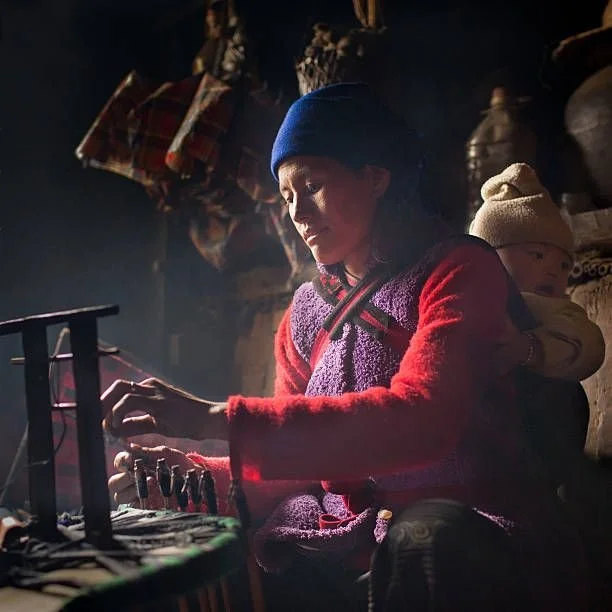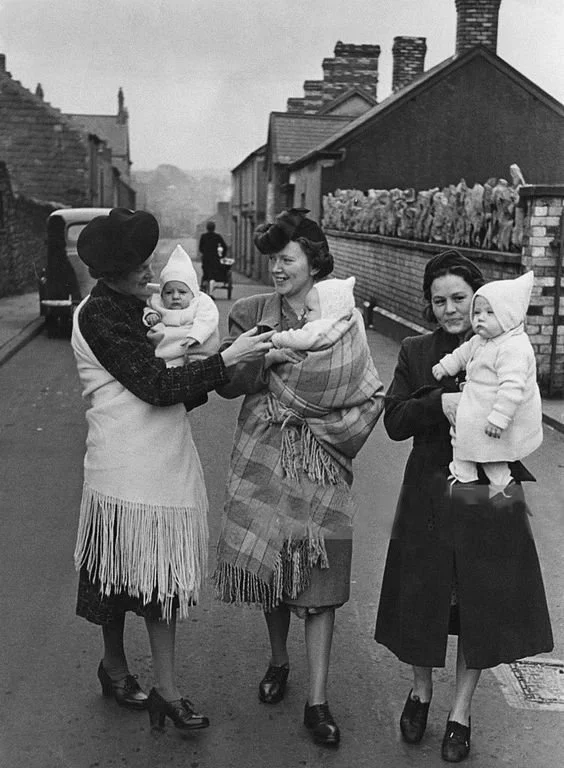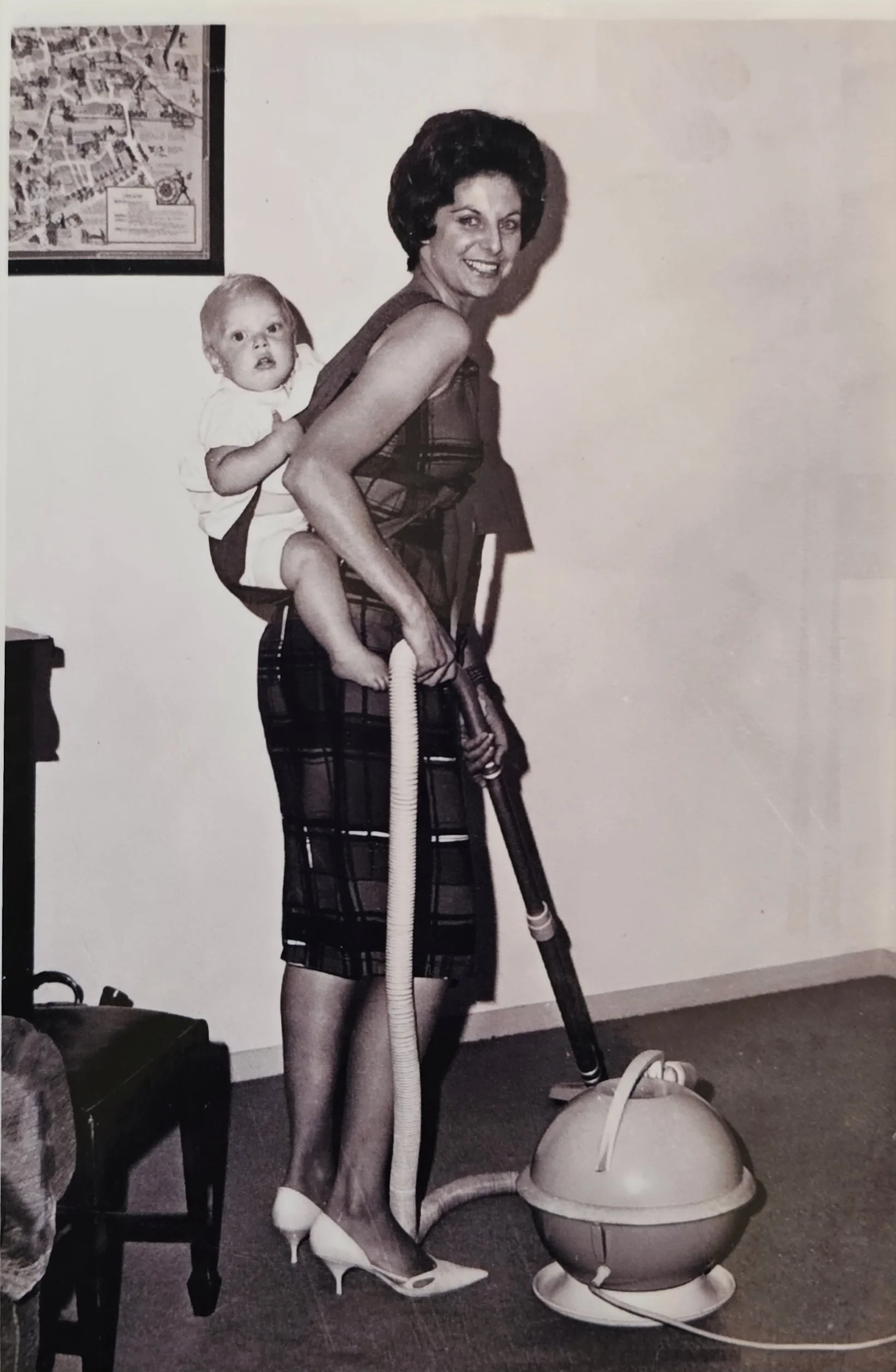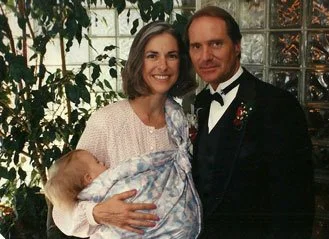The Evolution of Babywearing: From Necessity to Modern Movement
Carrying as a Lifeline
In traditional societies, carrying babies is not a choice — it is a lifeline. Caregivers need to gather food, tend fires, travel long distances, and participate in daily life, all while keeping their babies close and safe.
A woman weaves by lamplight inside a traditional Himalayan home, her baby carried high on her back in a thick, structured cloth carrier. The wide shoulder straps cross firmly across her chest, keeping her child nestled safely behind her as she works. With careful hands and deep focus, she tends to the loom — her posture upright, her strength steady. The baby’s knitted cap and relaxed body speak to the warmth and security of their bond, held close while daily life continues. This image reflects the deep interweaving of motherhood, craftsmanship, and tradition in Himalayan mountain communities — where generations are quite literally carried through the rhythms of everyday life.
Carriers are often handmade and passed down through generations, holding the stories and care of those who came before. In many communities, carrying is a shared responsibility: not only mothers, but siblings, aunties, and elders all play a part. Babies are held by many loving arms, and through this closeness, they learn the rhythms of family and community from their earliest days.
Disruption and Decline
The arrival of industrialization, urbanization, and Western colonial influence brought dramatic changes to parenting practices in many places. For example, the introduction of prams and cots marked a shift toward separating babies from their caregivers — a trend once celebrated as “modern” or “advanced.”
In this mid-century street scene from Wales, three women walk together with their babies warmly dressed against the chill. One mother carries her baby wrapped in a large checked wool blanket tied securely around her body — a practical and instinctive babywearing solution seen across many working-class communities. The woman beside her cradles her baby in arms, while another wears a fringed shawl over her coat, engaging warmly with the others. Behind them, wool fleeces are drying on a stone wall, hinting at the rural economy and textile traditions of the region. This photo captures the everyday strength and connection of mothers supporting one another — and the enduring closeness of carrying babies in arms and cloth.
Colonial and missionary movements often discouraged traditional carrying methods, viewing them as primitive or improper. Over time, this led to a decline in babywearing, especially among Indigenous communities, where carrying practices have always been woven deeply into daily life and cultural identity.
Rediscovery and Revival
In the late 20th century, there was a quiet but powerful return to traditional ways of caring for babies. Natural parenting movements and the rise of attachment theory began to highlight the importance of close physical contact for babies’ emotional and physical wellbeing.
In Australia, the Nursing Mothers’ Association (now the Australian Breastfeeding Association) helped reintroduce babywearing to a new generation of parents. In the 1960s, Mary Paton’s promotion of slings reignited interest in keeping babies close, and soon after, Meh Tai carriers began to appear.
A few years later, in the early 1970s, German mother Erika Hoffmann was inspired by a traditional wrap from South America she received as a gift and created Didymos, a brand of woven wraps which continues today.
A decade later, pediatrician Dr William Sears and his wife Martha a nurse, introduced the ring sling to the USA. The art of carrying babies had been rediscovered by western parents.
Martha Sears RN and her husband Dr William Sears
This revival is more than practical — it is a gentle reclaiming of ancestral wisdom, a recognition that closeness is not just convenient, but essential.
The Modern Movement
Today, babywearing is a vibrant global movement that honors tradition while embracing innovation. From wraps and slings to soft structured carriers, there is now a carrier for every family and every lifestyle.
More parents and caregivers are discovering how babywearing supports secure attachment, breastfeeding, and the confidence to move through daily life with their little ones close. Alongside this resurgence, there is a growing awareness of the importance of cultural respect — acknowledging and honoring the roots of these beautiful practices rather than simply adopting them as trends.
By choosing to carry, many families today are reconnecting with a timeless truth: babies are meant to be close. In this simple act, we carry forward generations of wisdom and love.
A note of gratitude and respect
We respectfully acknowledge and honor the individuals and communities depicted in historical images throughout this series. Many of these photographs were taken in times and contexts where informed consent as we understand it today was not sought or given, and some may have been created through coercion or exploitation.
We share these images with the deepest gratitude, not to romanticize or objectify, but to recognize and celebrate the strength, resilience, and wisdom of these cultural practices. We hold these ancestors and knowledge holders in our hearts and aim to represent their traditions with integrity, humility, and care.
We commit to continuing to learn, listen, and uplift the voices of contemporary community members and descendants, and we welcome guidance on the respectful sharing of these images.












